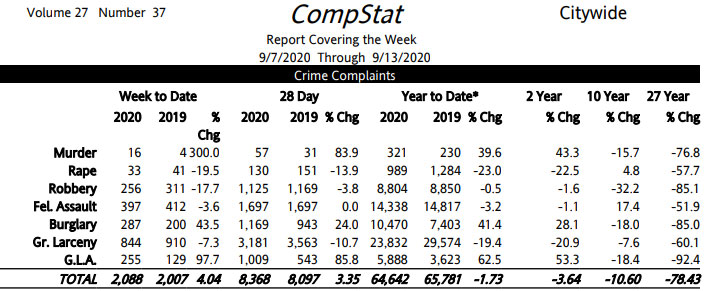To Tackle Covid and Climate Change, Invest in a Five-Borough MTA
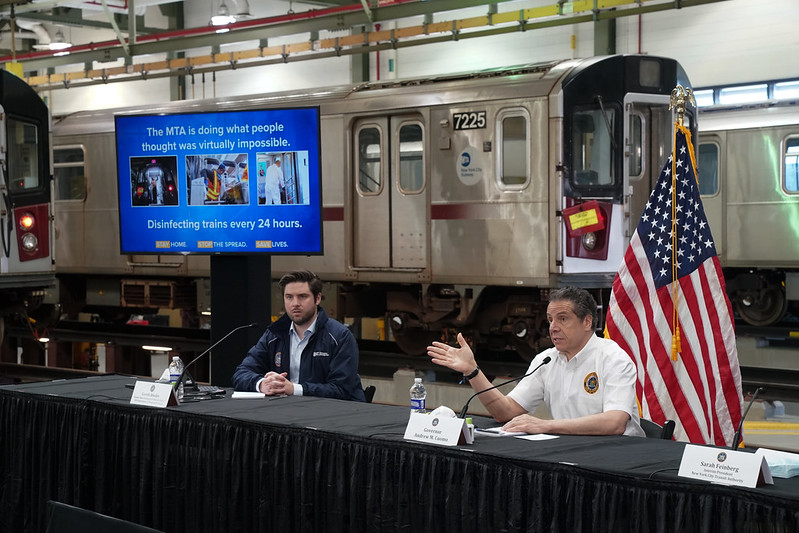
Governor Cuomo talks subways (photo: governor's office)
A city on the precipice of financial collapse. A federal government unwilling to provide help. Thousands of jobs and vital programs on the line. This was the situation in New York City in 1975, but this description is not far off from the picture in 2020.
Though the causes of these two crises were different, the effect will most likely be the same: massive budget cuts, especially to new projects. During the 1970s, the MTA was implementing plans to expand the subway system, including building the Second Avenue Subway, but scrapped them due to budget constraints. Fifty years later, the MTA is once again on the verge of collapse. But with the climate and economic crises escalating by the day, it’s imperative that politicians don’t make the same mistake this time.
As we’ve learned from previous downturns, cutting spending is counterproductive, as it only deepens recessions, leading to more job loss and thus more revenue loss. The MTA employs about 70,000 workers directly, and supports many more contracting jobs. According to the American Public Transportation Association, every dollar invested into transit yields about five dollars back.
It’s only fair that the wealthiest New Yorkers, the only people to actually experience financial gains during the pandemic, fund these investments upfront. Public transit is the lifeblood of this city’s economy, and those who benefit most from that economy ought to contribute to its well-being. Now is the time to tax the rich and expand transit service, not implement austerity on the MTA.
Mass transit is also vital to a Green New Deal. According to the Department of Transportation, public transportation releases anywhere from 33% to 76% less pollution per mile travelled than cars, with rail generating the most reductions. Transportation accounts for 28% of greenhouse gas emissions in the United States, the highest of any sector of the economy. Clearly a Green New Deal must not only tackle electricity generation and buildings, but also investing in transit.
But equally important to how much we invest in public transportation is where we invest that money. While it’s easy to get about in Manhattan by walking and taking the subway, the same is not true of the other boroughs. Manhattan has 9.2 subway stations for every 100,000 people, compared to 6.5 in Brooklyn and 3.5 in Queens. In terms of area, Manhattan has 64 subway stations per ten square miles, compared to 23.9 in Brooklyn, 16.7 in the Bronx, and a meagre 7.4 in Queens. Consequently, in the city renowned for its public-transit culture, a staggering 43% of ‘outer-borough’ residents live over a quarter mile from the subway.
As a Queens student who (in the pre-remote days) took three buses to get to my high school in the same borough, I know firsthand that outer-borough residents desperately need more and better transit options.
This disparity is only getting worse. From 2009 to 2017, the rate of private-sector job growth in the outer boroughs was over 30% higherr than in Manhattan. A Manhattan-centric subway system might’ve made sense in the twentieth century, but today the city’s economy is shifting. Expanding subway lines in Manhattan should take a backseat to addressing the dearth of public transit options in the other boroughs.
Adequately funded public transportation is also a justice issue. Median pay for workers in the outer boroughs is about half of what it is in Manhattan, meaning workers in outer boroughs especially need access to affordable public transit. The outer boroughs are also home to the largest immigrant populations in the city, with Queens and Brooklyn being home to about a million immigrants each. Additionally, the outer boroughs are home to many of the city’s Black residents, especially the Bronx with a 43.6% Black population and Brooklyn at 33.8%. New Yorkers of color rely on public transit at higher rates than the city average, especially Black and Hispanic New Yorkers. Thus, a reallocation of transit investment towards these boroughs not only makes economic sense, but promotes social and racial equity.
There are a number of possible ways to increase transit options in the outer boroughs. One idea, put forward by the Regional Plan Association, is to convert a stretch of underused freight track into a “Triboro” line connecting Co-op City in the Bronx to Bay Ridge in Brooklyn, with a possible extension across the Narrows to connect it to Staten Island. This plan, which is currently under consideration by the MTA, would facilitate transfers to major subway and LIRR stations and largely eliminate the need to take the subway through Manhattan to get around in the other boroughs. A Brooklyn College student who lives in Jackson Heights, for example, would save over an hour a day on their commute.
Another option is to reduce the price of commuter rail within the city. The MTA’s existing Atlantic Ticket and City Ticket programs offer reduced fares (between $4 and $5 dollars) for certain LIRR and MetroNorth trips. Some, including several City Council members and Comptroller Scott Stringer, propose going even further, advocating for a so-called “Freedom Ticket” that would reduce the cost of all commuter-rail trips within city limits to the standard $2.75 fare. A 2018 report by Comptroller Stringer’s office found that 18 of the 38 LIRR stations in the city are in neighborhoods without subway access, meaning that this investment would greatly benefit nearby residents. This proposed fare parity, combined with planned commuter-rail expansions such as the Penn Station Access line in the eastern Bronx, would go a long way to improving mobility in the outer boroughs.
There are many more strategies to increase outer-borough public transit, and we shouldn’t be afraid to get creative. From converting Moses-era highways into light rail to turning boulevards or abandoned rights-of-way into exclusive busways – the possibilities are almost endless if we have the vision. And we shouldn’t limit ourselves to just repurposing existing rights-of-way; while building new infrastructure (e.g., tunnels, elevated lines) is harder, creating new and sustainable structures and providing an economic boost in the process – and increasing the subway system’s resilience against the inevitable increase in climate-driven natural disasters – would truly embody the spirit of the Green New Deal.
But what we absolutely should not do is repeat the mistakes of the 1970s and scale down spending on transit. Now is the perfect time for revitalizing the MTA with an economically and racially just Green New Deal, and to tax the rich to fund it.
***
Anil Amir Singh is a high-school student in Queens and an activist with Sunrise NYC.
***
Have an op-ed idea or submission for Gotham Gazette? Email This email address is being protected from spambots. You need JavaScript enabled to view it.
Run, Kathryn, Run: Garcia Should Go from Shadow Mayor to the Real Thing
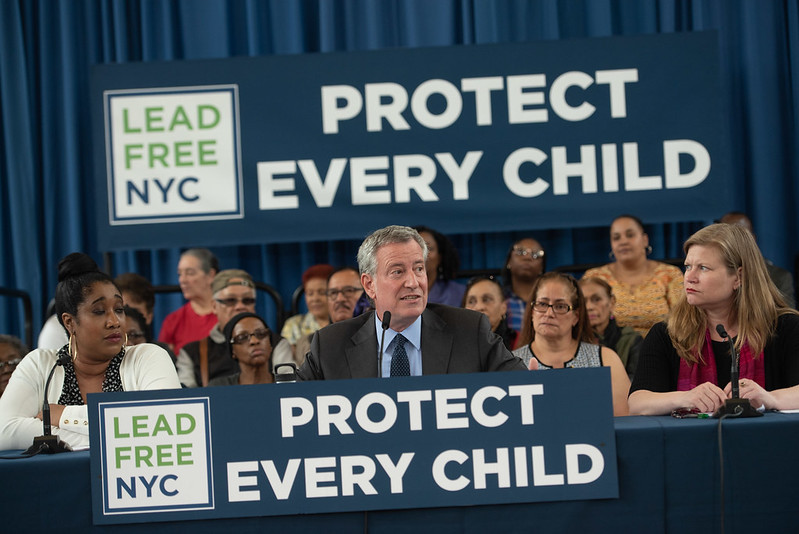
Kathryn Garcia, right, with the mayor (photo: Michael Appleton/Mayor's Office)
The next chief executive of the City of New York will have a portfolio of pressing problems, among them: raising the morale and prospects of a city decimated by well over 23,000 coronavirus-related deaths, closing Rikers Island jails, reducing a homelessness crisis, overseeing the development of a housing policy agenda that satisfies tenant advocates and landlords, funding the rescue of public housing, and addressing crowded schools.
These are challenges that only Kathryn Garcia can fix.
Garcia recently resigned as Commissioner of the Sanitation Department and announced that she’s exploring a run for mayor. She’s starting out with considerable disadvantages: the primary is less than nine months away, she has never held or run for elected office, she hasn’t fundraised, and while she enjoys name recognition within government circles, she has no name ID among the larger body of New Yorkers. But for a seasoned political operative, these are preferred qualifications and not prerequisites. An analysis of her performance as a government administrator, who can’t say no to a tough gig then does them well, would most likely generate positive and unbiased evaluations.
For New Yorkers, Garcia has been a kind of shadow mayor. Her agility has earned her the label of “go-to crisis manager.” A practicing environmentalist, she’s held high-level positions at the Department of Environmental Protection (DEP) and spearheaded the sanitation department’s ambitious sustainability goals. While she was at DEP, Superstorm Sandy hit New York. Drawing on her emergency planning experience, she was tapped as Incident Commander, where she was charged with bringing 42 pumping stations and a water waste treatment plant online. An arduous task, she accomplished it in three days. Garcia has significant experience orchestrating supply-chain initiatives that reach a million New Yorkers a day, and has been at the helm of NYCHA as interim chair.
To be clear, she is not the only viable candidate for mayor. Maya Wiley, the charismatic former MSNBC legal analyst and also a de Blasio administration alum, is a strong potential candidate. Comptroller Scott Stringer, an effective elected official, is also a competitive candidate. There are other contenders that have shown fundraising prowess and are mulling a mayoral run. Eric Adams, the Brooklyn Borough President, has been a great cheerleader for the city’s most populated borough, but how that readies him for City Hall is anyone’s guess.
Garcia doesn’t enjoy the spotlight or media fawning that other mayoral hopefuls have, but if she were to mount a run, the Democratic nomination could be within her reach, given her experience. Yet, in announcing that she’s considering a run for mayor, Garcia has already shown that she doesn’t understand her novelty. She’s tagging herself with buzzwords used by other potential and declared candidates. A campaign advisor, in an interview with the New York Times, noted that Garcia would cast herself as a “competent executive and non-ideological technocrat.” In an interview with City & State, Garcia stated that New Yorkers should judge her on her “accomplishments” and not her association with de Blasio. This kind of messaging is most effective if you were the least experienced person to jump into the race. More recently she made a better case on the Max & Murphy podcast, explaining her strengths as a “crisis manager,” and explaining that’s what the city badly needs in its next mayor.
If Kathryn Garcia wants to be mayor, she must say out loud what she’s so far keeping to herself: that she’s the most qualified candidate – and that’s exactly why New Yorkers need her.
***
Steven-Emmanuel Martinez previously served as Chief of Staff for the Office of Enforcement of Neighborhood Services at the New York City Department of Housing Preservation and Development, and has previously worked at the New York City Department of Social Services. He is now an independent consultant, tackling social welfare challenges at the intersection of health and housing.
***
Have an op-ed idea or submission for Gotham Gazette? Email This email address is being protected from spambots. You need JavaScript enabled to view it.
A Simple Way New York Can Help Renters and Owners
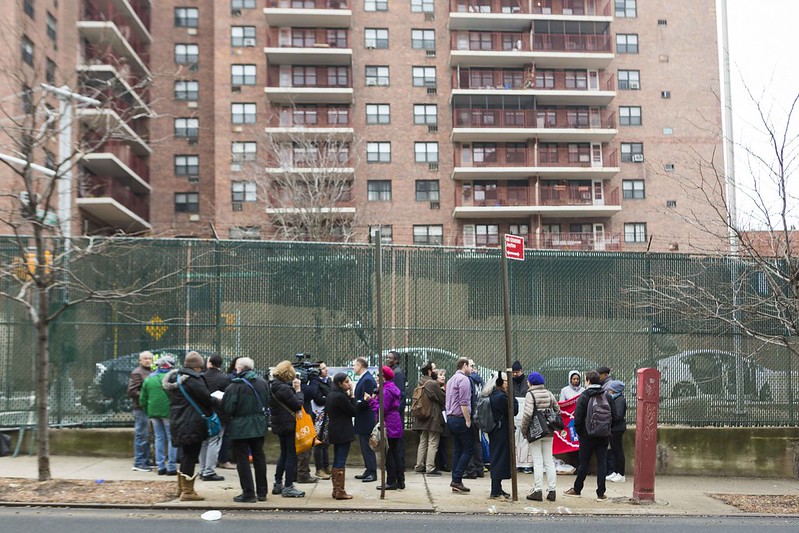
A proposed housing reform (photo: Emil Cohen/City Council)
In June 2019, state lawmakers significantly altered a provision of the rent stabilization laws called preferential rents. It was the ability for a housing provider to offer a rent that was lower than the legal limit, where such limits apply. Under the change in law, tens of thousands of tenants with preferential rents are locked in to rent increases that can never be more than what is determined by the Rent Guidelines Board annually.
But there are two sides to a coin.
Rent-stabilized tenants struggling because of the COVID-19 emergency are asking their housing providers for a break on rent. If the building owner grants it, it becomes the new legal rent for as long as the tenant lives there—potentially 20 years after the pandemic is over.
Let me give you an example. A 25-year-old renter pays $1,800-a-month for a stabilized two-bedroom apartment. They would like the rent reduced to $1,000 because their wages were cut in half. Many housing providers would consider cutting them this break for one- or two-year terms. Operating costs, insurance, and property taxes for an average New York City apartment add up to about $1,000 a month, so the building owner would be basically breaking even. Many would be OK with this during a pandemic, but under the current laws you are locked into that lower rent for however long the tenant lives there—which could easily be two decades. That would be $192,000 in potential rent loss.
If the flexibility in preferential rents was reinstated then rent-stabilized tenants would be able to negotiate fairer rents during this crisis. A recent survey of the members of the Community Housing Improvement Program (CHIP) found that more than half of rent-stabilized housing providers would cut their existing tenants a break on rent if flexibility in preferential rents was reinstated. Even more would lower asking prices on vacant rent-stabilized units if they weren’t going to be locked into a long-term reduced rent.
This will help housing providers too. Vacancy rates across the city are increasing at all price points. Owners need to keep their renters housed, even if they can only pay a portion of the rent. Many tenants are forced to move out of their homes in fear that they will accumulate debt they will never recover from, even though the building owner wants to cut them a short-term break. It is a lose-lose situation created by the laws passed in Albany and the pandemic.
When members of the state Legislature passed the Housing Stability and Tenant Protection Act of 2019, they never could have imagined a disaster like COVID-19. So, there is no shame in them tweaking the laws again to fit the new reality we face. It’s not an admission that they were wrong if they roll back this one provision, it is a demonstration that they can adapt laws as necessary to help people in a time of crisis.
The other great thing about bringing back flexibility in preferential rents is that it doesn’t cost the city or state a dime in their budgets. This simple tweak to the laws could help thousands of people without adding to the multi-billion dollar deficits faced by the state and the city. And when times get better, the rents could simply go back to the legal rents that they were before.
We also believe the city and state should put more funding towards voucher programs to support renters in need, with forgiveness tied to property tax off-sets similar to the current SCRIE or DRIE programs. This will also allow property owners to reduce rents and help renters who can’t pay because of the COVID-19 emergency. The budget constraints make this hard, but in a time of crisis secure housing has huge benefits to the health and welfare of our city’s most vulnerable people.
We can start by reinstating flexibility in preferential rents, which comes with no budget cost. It’s a small step, but we have to start somewhere.
***
Zachary Kerr is the president of the Community Housing Improvement Program (CHIP). On Twitter @nyc_chip.
***
Have an op-ed idea or submission for Gotham Gazette? Email This email address is being protected from spambots. You need JavaScript enabled to view it.
Note: this article has been corrected to say that the preferential rent system was "significantly altered" not "eliminated."
New York Must Replace Police as Responders to People in Mental Health Crisis
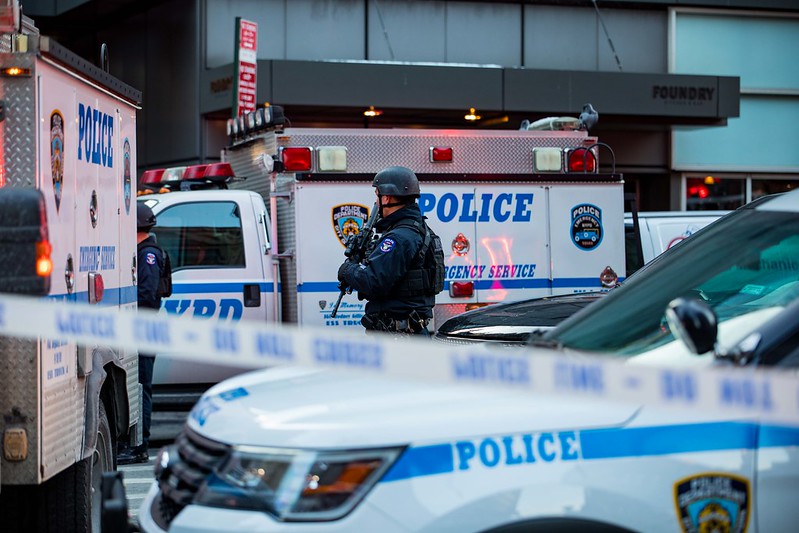
NYPD response (photo: Benjamin Kanter/Mayoral Photo Office)
The police must stop killing people of color. The police must stop killing people experiencing mental health crises. The police must stop killing people of color experiencing mental health crises. And the police must stop the cover-ups.
Daniel Prude, a Black man experiencing a mental health crisis, should never have been asphyxiated in the middle of the street on a snowy night, naked, begging and praying for help, held down and “hooded” with a bag over his head by seven Rochester police officers. But when something so heinous does happen – as it too often does – the public must immediately be made aware of it, and the officers must be held accountable. Instead, footage from the body-worn cameras of the officers who killed Prude was kept from the public for over five months, and the Rochester Police Department quietly determined the officers involved had done nothing wrong, despite the autopsy report clearly linking the police officers to the cause of death.
In New York City alone, 16 people experiencing mental health crises – 14 of them people of color – have died at the hands of the police over the last five years.
This needless killing must stop immediately.
The only effective way to address this ongoing issue is to remove the police from the situation entirely. Prude was a danger to no one but himself. He was scared and confused and needed help. He had a treatable medical condition. Police officers do not and cannot provide the help a person in Prude’s circumstances requires, any more than they could provide health care to someone experiencing a heart attack.
Mental health professionals, with specialized training and experience, should be responding to these situations – they can de-escalate crises and provide desperately-needed treatment. A team of trained first responders should also include “peers” who have experienced mental health crises firsthand, so they can offer the expertise and compassion an individual experiencing a mental health crisis requires.
Eugene, Oregon, already has a program in place that has revolutionized this area of public health by utilizing mobile crisis intervention teams made up of a medic and an experienced crisis worker and using trauma-informed de-escalation and harm reduction techniques. The program has been saving lives (and money) for over 30 years and demonstrates the many advantages of non-police emergency response teams.
Since then, places like Denver, San Francisco, Los Angeles, and New Haven have put similar programs in place or recently voted to implement them. Adoption of such a program in New York City is long overdue. Correct Crisis Intervention Today – NYC (CCIT-NYC) has proposed an ambitious pilot program starting in two police precincts with the largest number of 911 calls relating to mental health, where trained teams of emergency medical technicians and peers would respond quickly and compassionately to de-escalate crises and prevent harm.
New York City must adopt the CCIT-NYC program immediately.
While the city considers alternative models to police response, the public needs quick access to unedited body-worn camera footage of police encounters with people experiencing mental health crises. As we saw in Prude’s case, such footage exposes beyond a doubt that police are not even remotely suited to respond to mental health crises.
Unfortunately, in most places, police departments and politicians speak out of both sides of their mouths on public access to body-worn camera footage. Politicians, including Mayor de Blasio, like to brag about police reform, but too often remain beholden to the status quo.
In June de Blasio promised that much NYPD body-worn camera footage would be released within 30 days after violent incidents. Yet, the release of footage continues to be quietly delayed. For example, civil rights organization New York Lawyers for the Public Interest requested footage of the fatal police encounter with George Zapantis. Despite the mayor’s new policy, the NYPD has refused to release the footage and has not even said when or if it will be released.
Prude’s tragic and grisly death is not an isolated incident. Time and again, footage of police interactions with people experiencing mental health crises shows the utter failure of police officers to properly respond under these circumstances, and how police responses lead to the unnecessary loss of human life.
New York Lawyers for the Public Interest has been forced to bring the fight for access to body-worn camera footage to the courts. Despite a three-year legal battle with the city, including landmark court decisions requiring full disclosure of footage of the fatal police shootings of Miguel Richards and Susan Muller, the NYPD continues to systematically deny public access to footage. As was the case for Prude, whose horrific death was, until recently, known to few, video footage plays a critical role in advancing accountability and reform. The mayor must take immediate action to ensure that unedited body-worn camera footage is available to the public without delay.
Not another life should be lost at the hands of the police. It is high time for New York City to institute a system for responding to medical emergencies that is totally separate from law enforcement. There is absolutely no place for police in the treatment of people experiencing mental health crises.
***
Marinda van Dalen is a Senior Staff Attorney with the Disability and Health Justice programs of New York Lawyers for the Public Interest and lead counsel in efforts to obtain body-worn camera footage.
Christina Sparrock, board member of Citizen Action of New York and CCIT-NYC steering committee member, has lived mental health experience and advocates for legislation to reform New York City’s response to mental health crises.
Kevin S. Parker is the New York State Senator for the 21st District in Brooklyn who, together with mental health advocates, is drafting legislation to change the response to mental health crises across New York State.
***
Have an op-ed idea or submission for Gotham Gazette? Email This email address is being protected from spambots. You need JavaScript enabled to view it.
Letter to the Editor: The Assembly Member’s Bad Bank Note
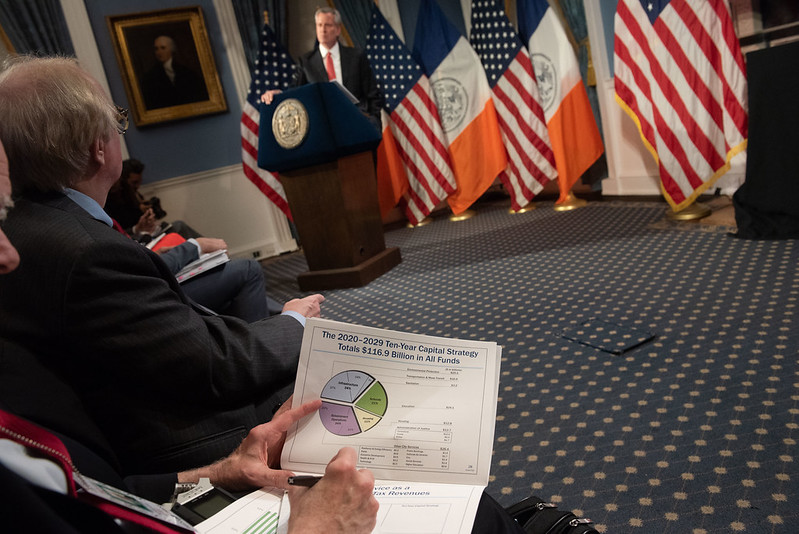
A budget presentation (photo: Michael Appleton/Mayoral Photography)
To the Editor:
In an op-ed recently published by Gotham Gazette, Assemblymember Ron Kim advanced an ill-informed and dangerous argument that, instead of issuing the $5 billion in debt the Mayor is seeking through the municipal bond market, the city should instead borrow from the Federal Reserve’s Municipal Liquidity Facility (MLF).
The MLF was created as part of the Federal Reserve’s response to the pandemic, to provide emergency cash-flow lending to state and local governments.
Assemblymember Kim argued that owing the Fed money is preferable to paying interest to wealthy bankers and investment firms, and suggested that since it is a federal entity, the Fed wouldn’t really expect the loan to be paid back:
“Borrowing from the MLF is more like borrowing from a family member with a magical money tree in their backyard -- we don’t really have to worry too much about paying them back on time…The Fed will never come down on New York to bankrupt us, privatize public services, or negatively impact our credit ratings because their deficit ultimately adds real value to our communities.”
As Federal Reserve Chair Jerome Powell has stated, the MLF is a backstop to the municipal bond market, not a substitute. It is intended to help states and cities tide themselves over cash flow problems caused by situations like the extension of time granted to pay income taxes. Its loans are short-term only, to be paid back within three years. Most jurisdictions -- including New York City, which has a AA+ excellent bond rating -- will get lower interest rates and much longer terms in the municipal market, which is why only two entities with very poor bond ratings have actually borrowed from the MLF so far, the State of Illinois and the Metropolitan Transportation Authority (MTA).
The kind of long-term borrowing Mayor de Blasio seeks is not allowed through the MLF.
The dangerous part of Assemblymember Kim’s proposal is the suggestion that we would not have to pay back the MLF when the bill comes due, and that the Federal Reserve would not try to collect.
The repayment terms of MLF bonds are the same as those of other municipal bonds in that they are required to have investment grade ratings and the Fed and U.S. Department of Treasury have the same enforcement rights and remedies as other bondholders. Among other conditions, such loans must be secured in a manner that "protects the taxpayer against loss” and cannot be made to insolvent borrowers and may not be forgiven.
If the loans can’t/don’t get paid back on time it’s a default whether the Fed comes after the city to collect or not. That would be a disaster: our credit would immediately go to junk rating, and we would lose market access for all our municipal bonds, leaving us unable to pay for our capital program, which would have to come to a total stop.
I’m sorry, Assemblymember Kim, there is no magical money tree in a family member’s backyard.
Sincerely,
Carol Kellermann, former president of Citizens Budget Commission
***
Carol Kellermann was president of Citizens Budget Commission from 2008 through 2018.
***
Have an op-ed idea or submission for Gotham Gazette? Email This email address is being protected from spambots. You need JavaScript enabled to view it.
A Critical But Too Often Ignored Piece to New York City’s Economic Recovery
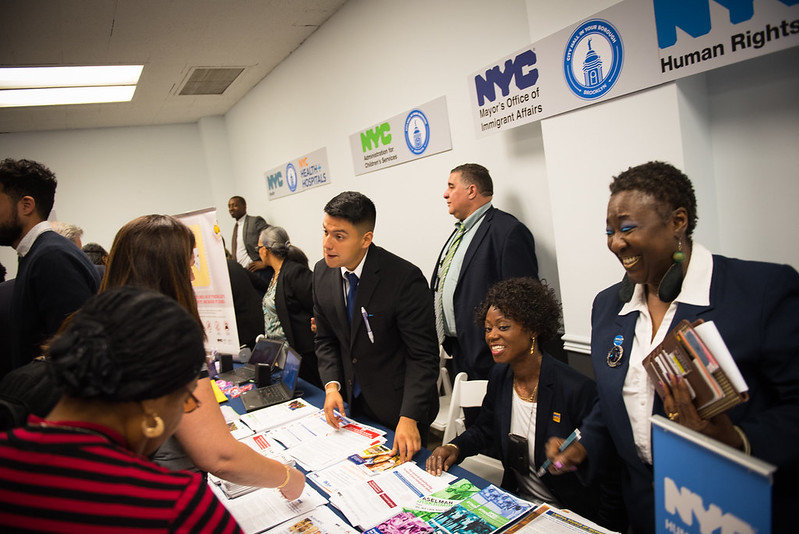
A resource fair (photo: Edwin J. Torres/ mayoral Photography Office)
Getting people back to work safely after the record-breaking job losses seen during the pandemic is on everyone’s mind. While this will require a multi-faceted approach, the frontline workforce field, i.e. the professionals responsible for training and connecting marginalized jobseekers with employers looking for skilled workers, is generally overlooked in this conversation. Real economic recovery won’t happen without clear and strategic investment in the workforce development training sector.
The field is no stranger to supporting underserved communities behind the scenes during tough economic times. They supported low-income workers and jobseekers through the labor market downturns after 9/11 and during the Great Recession, stagnant minimum wages and welfare reforms, and stop-and-frisk policing that created lifetime criminal records used to deny employment.
Food service, hospitality, retail, and personal care industries were hit hardest by the pandemic, which disproportionately employed low-income workers and workers of color. Even if the economy bounces back and jobs quickly become available, low-income communities in New York City don’t have adequate access to the skills and background experience needed to acquire many of them.
Businesses in every sector are rethinking operations, requiring updated skills from employees. Preexisting education and digital literacy barriers put low-income communities at a significant disadvantage in securing stable and sufficient employment in a post-pandemic world. Given how quickly jobs are changing and industries are innovating, there now needs to be even more consideration around how to prepare people for available jobs long-term.
In order to meet this historic challenge, we need to fully understand the needs of the sector dedicated to getting folks back to work. Over the past few months, Workforce Professionals Training Institute (WPTI) conducted a series of surveys analyzing frontline workforce professionals and the industry at large, and released the first in a series of reports titled “An Introduction To New York City’s Frontline Workforce Professionals” outlining who they are, who they serve, and what they need to succeed.
The 362 professionals surveyed confirmed a lot of what we already knew. Frontline workforce development professionals are disproportionately women (67%) and people of color (72%) who are often underpaid and in precarious situations themselves. Despite having higher education levels than other NYC employees on average, they earn lower wages. Just over one-quarter of respondents agreed that their take-home earnings are only enough to cover basic living expenses.
Making matters worse, there’s no clear pipeline to the workforce development training field and rarely a clear career trajectory or job description once you’re in it. Many respondents anecdotally noted that they “fell into” or “stumbled upon” this field. Seventy percent (70%) of survey respondents agreed that they would like to advance within their current organization, but less than half feel that requirements for advancement are clear. Simultaneously, 72% indicated being responsible for four or more distinct job responsibilities and, even more troubling, nearly one-quarter selected an overwhelming 10 or more duties. It’s important to note that these responses were captured before the COVID-19 pandemic: this doesn’t capture the added pressure of bringing previously in-person programs entirely online and addressing digital literacy gaps and broadband access needs.
While the sector doesn’t need fanfare to do this work, the systemic barriers they face are now too large to ignore. With state and city budget shortfalls likely to cause short- and long-term delays in government contracts and other funding, we need the private sector and the federal government to supplement existing funding for the workforce development sector to adequately address this crisis. In order to encourage greater talent retention and create the best possible outcomes for jobseekers, we need to encourage retention and invest in the field with the experience and expertise needed to get New Yorkers back on their feet and into careers with growth potential.
COVID-19 has permanently changed many aspects of life, and the workforce development sector is no exception. For employers to more easily access qualified talent as the job market expands again, they – and we as a city – need frontline workforce professionals.
***
Sharon Sewell-Fairman is the Executive Director of the Workforce Professionals Training Institute. On Twitter @WPTIorg.
***
Have an op-ed idea or submission for Gotham Gazette? Email This email address is being protected from spambots. You need JavaScript enabled to view it.
Giuliani’s Rant on Crime in New York City: The Numbers Tell a Different Story
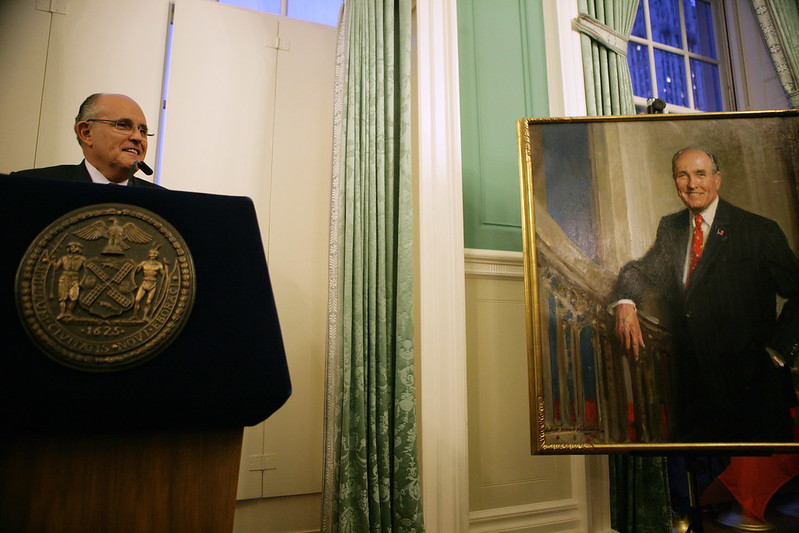
Rudy Giuliani at City Hall (photo: Kristen Artz/Mayor's office)
Former Mayor Rudy Giuliani launched an attack on Mayor de Blasio, blaming him for rising crime and crowing about how safe New York City had been until de Blasio took over. Giuliani reportedly said, “We went from being the most dangerous city to the safest large city in America, and we remained there until this idiot took over.“ It is certainly terrible that murders so far this year have increased compared to last year, nobody likes to see that. But if one chose to actually go back to Giuliani’s final year as mayor, 2001, the city was in fact less safe, with far higher crime levels across the board, including murder, than today.
NYPD Crime Statistics clearly bear this out. Before taking a look at the overall stats, one can acknowledge murders are up this year in the city compared to last year.
According to NYPD data for the year to date, there have been 321 murders in New York City from the beginning of the year through the week of September 13, compared to 230 through the same period last year, a 39.6% increase.
Nonetheless, murders were substantially higher in Giuliani’s final year in office than they are now. Below is the NYPD Historical Perspective data set, also published by the NYPD as part of the CompStat Crime Statistics along with the current crime stats. There were 649 murders in 2001, the former mayor’s final year, compared to 319 in 2019.
With 321 murders in the 36 weeks through September 13, 2020, the pace of murders in the city this year is about nine per week. Even if that pace continues, there would still be fewer murders in 2020 than in 2001, or 1998. With 15 weeks and a few days left in 2020, that pace would bring the City to 470 murders, about 28% below 2001 and 24% below the low point of Giuliani’s mayoralty in ‘98. That means to return to the lowest yearly number of homicides of the Giuliani Administration would be, to some like Giuliani, a return to ‘The Bad Old Days.’
In addition to the number of murders being far higher in 2001 than 2019, and higher in ‘01 than 2020 even if the current pace is sustained, levels of crime as measured by the FBI Index of major felonies across New York City were higher in all categories in Giuliani’s final year in 2001 than in 2019.
The NYPD CompStat table shows crime in New York City in the seven major felony categories was down 41% in 2019 compared to 2001, and 55% lower than 1998.
Crime in the city in 2020 is actually down or flat in some categories compared to last year, and has spiked in some other categories. Below is the NYPD comparison for the seven Index crimes for this year, compared to last year.
There are various ups and downs in the crime numbers this year compared to last. The number of reported rapes through September 13 declined from 1,284 to 989, down 23% over the same period from a year ago. Robbery and felony assault levels are flat, down one-half of one percent for robberies and down 3% for felony assault. Burglaries are up 41% and larcenies are down 19%. Grand larceny auto is up over 60%, rising from 3,600 by this time last year to nearly 5,900 this year.
Giuliani was praised for his success in cutting vehicle theft, but in 2001 there were still over 29,600 vehicle thefts, or 569 a week. Despite the considerable increase in vehicle theft this year, the current pace is 163 a week, still down 71% compared to Giuliani’s final year. The current pace of robberies remains 50% below the 2001 level, and the current pace of burglaries remains 54% below 2001.
One can go back to Giuliani’s first year to take a look at murders in the city, and all the way forward to the present, through the Bloomberg and now de Blasio administrations:
NYC MURDERS 1994-2019
| Giuliani | Bloomberg | De Blasio | |||
| 1994 | 1561 | 2002 | 587 | 2014 | 328 |
| 1995 | 1177 | 2003 | 597 | 2015 | 352 |
| 1996 | 983 | 2004 | 570 | 2016 | 335 |
| 1997 | 770 | 2005 | 539 | 2017 | 292 |
| 1998 | 663 | 2006 | 596 | 2018 | 289 |
| 1999 | 671 | 2007 | 494 | 2019 | 319 |
| 2000 | 673 | 2008 | 522 | 2020 thru 9/13 | 321 |
| 2001 | 649 | 2009 | 471 | ||
| 2010 | 534 | ||||
| 2011 | 515 | ||||
| 2012 | 414 | ||||
| 2013 | 332 |
(Source: Wikipedia (there appear to be some small discrepancies between the Wikipedia data and the NYPD Statistics as presently published))
There were 7,117 murders in Giuliani’s eight years as mayor of New York City and 6,171 murders in Bloomberg’s 12 years in office. For the first 6 and 2/3 years under de Blasio, there have been 2,236 murders. I think that means the city is more safe, not less, under Mayor de Blasio than under Mayor Giuliani.
The point here is not to deny Rudy Giuliani some credit for a safer New York in the 1990s, or to suggest that the current increase in crime isn’t a serious concern -- it is, and the mayor, the Police Department, and the city government need to address it in a way that brings people together, no matter how difficult that is. But as the data show, Guiliani’s comments about de Blasio’s New York City do not hold much water.
***
Jim Brennan was a member of the New York State Assembly for 32 years, where he chaired four committees. On Twitter @JimBrennanNY.
***
Have an op-ed idea or submission for Gotham Gazette? Email This email address is being protected from spambots. You need JavaScript enabled to view it.
De Blasio's Cuts to Jail Oversight Must Not Stand
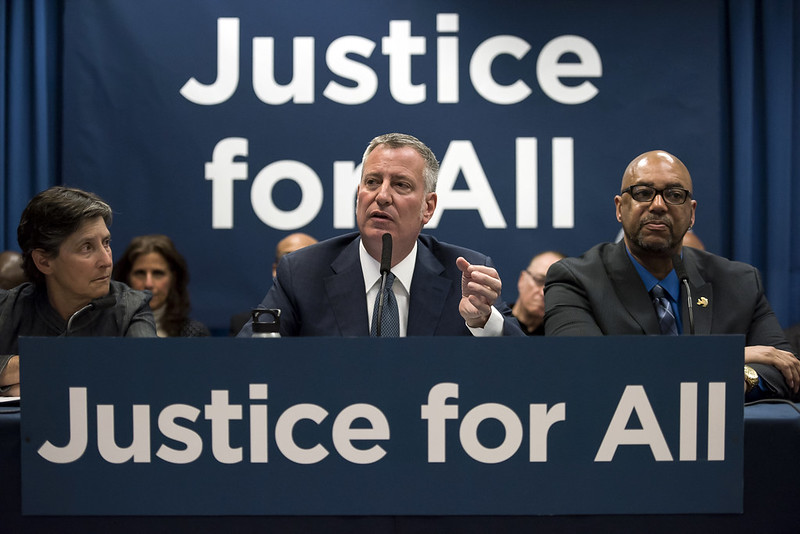
Mayor de Blasio (photo: Ed Reed/Mayoral Photography Office)
New Yorkers are beyond tired of the tale of two mayors: one who claims to be committed to substantive reform of New York City’s criminal legal and jail systems and another who resists, delays, and undermines efforts to address the deep injustices of those same systems. The first mayor touts his support for closing Rikers Island jails, ending solitary confinement, and releasing people from jail at the onset of the coronavirus outbreak — though he came to these positions only under constant pressure by advocates, and we are often reminded that he has not truly understood our demands.
The other mayor tells a very different story with his actions, such as his support for expanding the use of bail (and willingness to amplify his NYPD’s efforts to spread fear about bail reform), his choice to prioritize the jobs of police and correction officers over human services, his unwillingness to address ongoing abuse by law enforcement, and most recently, his plans to cut jobs at the Board of Correction by 31% compared to last year.
For most New Yorkers, the Board of Correction may be a relatively unknown agency. The BOC is an oversight board that regulates, monitors, and inspects facilities run by the Department of Correction (DOC). The Board is supported by a small staff of 25 that is already too small to fully meet its mandate. The Board’s budget is only 0.23% of the Department of Correction’s budget, compared to the Civilian Complaint Review Board, a police oversight entity whose budget is now set at 1% of the NYPD’s personnel budget.
The BOC’s oversight role is at least as crucial as the CCRB’s, if not more. The NYPD’s brutality can sometimes be seen in public, recorded by cell phone cameras, and shared widely, but abuse of people in the city’s jails happens behind locked doors, and only the Department of Correction and Board of Correction have access to the video evidence.
Over the five years that DOC has been under a federal monitor for excessive use of force against people in their custody, use of force has only increased — to rates now 105% higher than in 2016. This month, New York City settled a $5.9 million lawsuit with the family of Layleen Polanco, and recently disciplined 17 correction officers involved in her death, after an extensive report by the Board. In the wake of COVID-19, the Board has also served an essential role in advocating to keep incarcerated people safe (including by releasing people), and compiling regular reports about management of COVID-19 in the jails. These reports have been critical in substantiating the sweeping claims by people in custody that safety protocols touted by the Department of Correction have not been happening in practice. The voices of people in custody are too often discredited by prosecutors, judges, and other stakeholders, leaving the Board’s monitoring and subsequent reporting essential to elevating the many safety concerns voiced from inside the jails.
There has probably never been a worse time to cut back on jail oversight. Despite the revenue shortfalls New York City is facing, this disaster can be avoided by looking to a much more appropriate place for budget cuts: the department that is perpetrating these abuses against New Yorkers. The Department of Correction has more than two uniformed officers for every person in custody — amounting to the highest jail staffing ratio in the United States, more than eight times higher than the national average. Despite that ratio, the Department’s budget still includes over $60 million for overtime. The Federal Nunez Monitor’s most recent report said that this overstaffing is actually driving more violence against people in the jails, especially through Probe Teams (essentially riot squads), which still have an operating budget over $37 million.
Mayor de Blasio faces a clear choice here, and the decision he makes will have life-and-death consequences for people in the custody of his Department of Correction. He can choose to cut the Board of Correction budget and worsen the human rights crisis on Rikers Island and in all city jails. Or he can preserve the Board’s budget and essential functions, a necessary step that must be followed by further action to finally end the Department of Correction’s reign of terror.
***
Darren Mack and Roger Clark are formerly incarcerated leaders and members of the Jails Action Coalition. On Twitter @iamdarrenmack & @JailsAction.
***
Have an op-ed idea or submission for Gotham Gazette? Email This email address is being protected from spambots. You need JavaScript enabled to view it.
4 Steps to Fix the City’s Ongoing School Reopening Failures
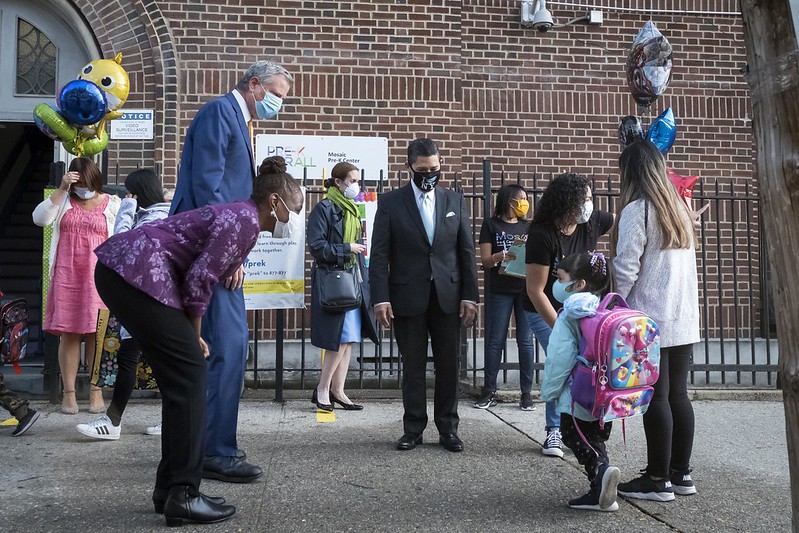
Mayor and Chancellor on first day of school (photo: Ed Reed/Mayor's Office)
This city continues to fail us as we attempt to begin the school year safely. Not utilizing any of the months since March to make a safe, equitable reopening plan is unacceptable, and the constant changes to the plan are throwing the lives of many families and educators into complete disarray. It’s time to chart a better path.
Each week brings daily changes as leadership continually pulls the rug out from under students, parents, and educators. Late last Tuesday evening, the night before teachers were set to meet their students online, the mayor announced yet another change to the remote learning policy: students in the hybrid learning model will no longer be guaranteed live remote instruction. Some students will learn from a computer while at school.
The number of teachers and administrators testing positive for COVID-19 has continued to rise, increasing the concern that positive cases only grow as students and teachers come back to school.
Next, just four days before school was to start in-person, the mayor announced another delay, pushing the start of school back to the beginning of October for many students.
As a special education teacher in our public school system and the parent of two young children, as well as a candidate for City Council, I have been speaking out about the inexcusably poor handling of this disjointed reopening planning for months. There is no doubt that the mayor and the Department of Education completely neglected their responsibilities to our students, our educators, and their families.
Throughout the processes of the closure and reopening of schools, shortsighted planning has been incredibly harmful and led to confusion and stress for our educators and families. Educators need to plan how we will meet the social-emotional, mental health, and academic needs of our children, while families want the best for our children and need to be able to plan for our own work schedules. This lack of planning has been an all-too-frequent hallmark of the current administration, which has let down students, educators, and most New Yorkers on schools and much more.
Instead of treating every student as if they have the same needs, our City needs to reimagine how we’re approaching school reopening, just as we need to reimagine every aspect of our city’s recovery to ensure it is both deliberate and just. Here are four key steps:
Clarify safety standards. According to the Department of Education’s website, a classroom can be cleared by having “at least one functioning method of ventilation,” which could be “a window that opens, a type of mechanical ventilation (exhaust fan, supply fan, unit ventilator) or a combination of the both.” However, even Donald Trump’s EPA notes that “Even with an open window or door, natural ventilation can be limited if inside and outside temperatures are similar and there is little wind.” We must have rigorous and transparent standards regarding our safety if we are to build confidence and trust in a school’s ability to host in-person learning.
Recognize the dual roles of schools as places of learning for our next generation and of child care so parents can go to work, while understanding that different students and families have different needs. We should prioritize in-person learning for students with disabilities, young students, English language learners, students from high-need homes (homeless, food insecure, etc.), and students from families with other major needs, allowing them to have as many days and hours of in-person learning as possible.
With that in mind, older students who are more self-sufficient and independent -- mainly high school students, with exceptions for high-needs students and families -- should have all-remote learning, with the opportunity to participate in counseling and extracurriculars as needed. After all, a 5-year-old with a disability has a greater need for more robust in-person learning than a 16-year-old student. Their educational and emotional needs are not the same, and a family’s child-care needs are not the same with regard to different age groups.
I agree with the latest decision by the city to phase in in-person learning beginning with the students that need it most, but it is insulting that they announced the change days before school was to start in-person for everyone participating in blended learning. Even with this, there would still be many families who want their children to learn remotely, which would be feasible as there will still be teachers who will teach remotely.
Be resourceful in maximizing our space, especially as the weather changes. While there are many avenues to utilize outdoor spaces like recess yards, NYC Parks, and closed off streets, this is only viable until it becomes unsafe to spend extended periods of time outside. If fewer high school students are in attendance, those buildings can be put to use for younger students or students with additional needs. If we want to further consolidate the number of school buildings in use, we can also be flexible with scheduling for older students, which is made easier by the fact that many high schools’ in-person models do not have students in attendance for a full school day anyway.
Provide more consistent guidance and recognize the hardship parents, students, and teachers are dealing with as we adjust schedules and teaching plans last minute. The mayor and his administration have continually disrespected parents, students, and teachers with plans changing at the last minute. Once we begin in-person learning, deadlines must be given and held. Teachers and parents deserve to know the benchmarks and timelines for ensuring school is safe and meeting the needs of all students.
For weeks, students, parents, and educators have been sounding the alarm about the city’s preparedness for school, and it is incredibly frustrating that the city’s leadership continues to fail us. Parents made decisions based on promises from the city, and the city’s inability to plan adequately reflects the incompetence of the planning and implementation of a coherent plan.
We can’t have a functioning city without consistent guidance and residents trusting city leadership. We need leaders who listen to New Yorkers and who can reimagine the way we educate our children -- and we deserve better, more creative approaches for those who feel forgotten by the bureaucracies at the Department of Education and City Hall.
***
Eric Dinowitz is a special education teacher and a candidate for City Council in the 11th District in the Bronx. On Twitter @EricDinowitz.
***
Have an op-ed idea or submission for Gotham Gazette? Email This email address is being protected from spambots. You need JavaScript enabled to view it.
AirTrain LaGuardia is Economic Stimulus New York Needs to Turn The Corner

Rendering of the Airtrain LaGuardia (photo: A Better Way to LGA )
When it comes to rebuilding an economy mired in crisis, my brothers and sisters in the Building and Construction Trade unions have been on the front lines time and time again. We know that building back our economy always begins with building up our infrastructure better than before. And today is no different.
AirTrain LaGuardia is a perfect example of an infrastructure project that can lead the way in putting New York City back on its feet. Construction of AirTrain will get 3,000 skilled union members back to work in good-paying jobs at a time when those jobs – and the additional economic activity they will create – are sorely needed.
Members of the building and construction trades suffered greatly during the pandemic. At one point during the spring, 975,000 construction workers around the nation were unemployed as job sites shut down due to the deadly threat of COVID-19.
Yet at projects deemed essential here in New York, including the building of a new LaGuardia Airport, our union workers continued to show up every day. We worked with our partners to make the job site as safe as possible, and we kept the project moving forward on time, as you saw with the opening of a new Terminal B in June.
Thousands of construction workers at LaGuardia earn a paycheck, support their families, pay their mortgages, and patronize local businesses around the airport. Infrastructure projects like AirTrain LaGuardia will continue that opportunity, not only supporting our construction workers, but supporting entire communities.
That’s why we at Laborers’ Union Local No. 731 strongly support AirTrain LaGuardia, which will create the kinds of jobs we need most – jobs that are a pathway to the middle class. And thanks to expansive apprenticeship programs offered by the Building and Construction Trades Council of New York, as well as our local, these are jobs that are increasingly filled by people of color, women, and military veterans from right here in the five boroughs.
AirTrain LaGuardia, like the transformation of LaGuardia Airport, will also create new opportunities for Minority- and Women-Led Business Enterprises and local businesses based in Queens. More than $1.4 billion in contracts were awarded to MWBE firms for work at LaGuardia Airport. Roughly $500 million in contracts went to Queens-based companies. AirTrain will continue that policy of equity.
LaGuardia Airport is the only major airport on the East Coast without a rail mass-transit link. That was unacceptable in years past and it is even more unacceptable going forward as our workers build the nation’s most technologically sophisticated, efficient, and beautiful airport in the country.
AirTrain would create a dependable ride from the airport to Midtown Manhattan, taking less than 30 minutes with a connection at Willets Point to either the LIRR or the No. 7 subway. Based on surveys of passengers at LaGuardia, as many as 10 million travelers a year would use AirTrain, removing millions of vehicles annually from congested highways and local streets.
Unlike the other alternatives, some of which have been debated for decades, AirTrain LaGuardia would take no private property and would not run through any residential neighborhood or commercial districts. It would be separated from the nearest homes by the eight-lane Grand Central Parkway.
This is a project that can get done. The Port Authority and our union workers have a track record of completing major infrastructure, including AirTrain JFK, a project that I am proud to have worked on for four years as a shop steward. Our skilled union workers built AirTrain JFK, which has been successful far beyond expectations, outpacing paid ridership projections by 55 percent and serving as a catalyst for more than $1 billion in private and public investment in downtown Jamaica.
A new AirTrain LaGuardia connecting to expanded LIRR and subway service could play the same role by jumpstarting the redevelopment of a blighted, industrial site at Willets Point into a new neighborhood with mixed-income housing, shops, hotels, a new school and new parks astride some of the city’s great attractions, creating even more jobs for our building and construction trades and opportunity for all New Yorkers.
We can no longer afford to waver and delay before moving forward. Waiting is not an option during an economic crisis. Now is the time to invest in a 21st century infrastructure for a 21st century post-covid economy by moving forward with AirTrain LaGuardia. The skilled men and women of our New York’s Building and Construction Trades Council, including Laborers Local 731, stand ready.
***
Carmine D’Amato is the Assistant Business Manager for Laborers’ Union Local No. 731
***
Have an op-ed idea or submission for Gotham Gazette? Email This email address is being protected from spambots. You need JavaScript enabled to view it.
Economic Development in a Pandemic: Let's Launch The Bronx Reconstruction Program
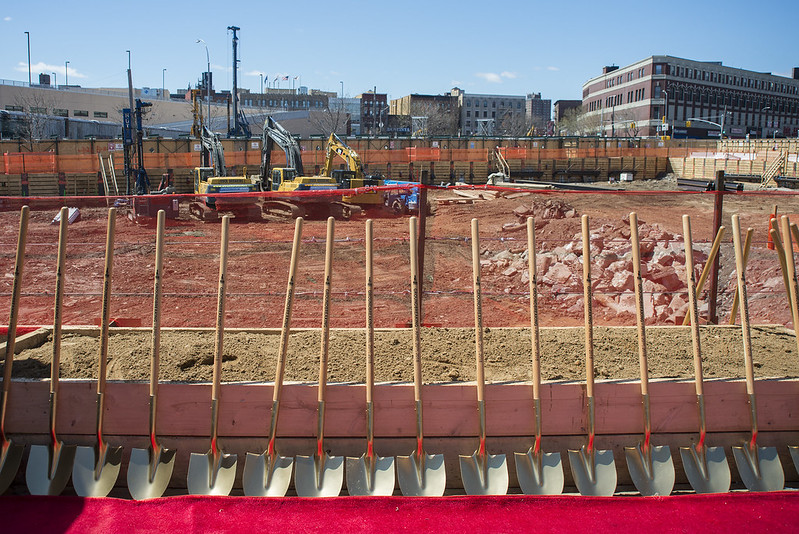
A ground-breaking in the Bronx (photo: Jeff Reed/City Council)
Recent events have made it abundantly clear that the Bronx needs new, creative solutions. To rebound and rebuild stronger from the crises we face, we need policies that bring equity to economic opportunity; sustainable, liveable neighborhoods with great local schools; resilient communities; affordable, accessible transportation; and local input from the community about decisions affecting the community.
In that spirit and as part of my candidacy for New York City Council in the Bronx’s District 11, I am proposing that the Bronx become a pilot for a job-creation program modeled on, but more equitable than, the Civilian Conservation Corps started by President Franklin Delano Roosevelt during the Great Depression.
The Bronx Pandemic Reconstruction Program would include free training and education so that all Bronxites are equipped with the skills for adapting and thriving in the 21st century. The program would focus on communities of color and the communities most severely impacted by the pandemic-spurred economic collapse.
Employment
The Bronx Pandemic Reconstruction Program would create 10,000 jobs by offering unprecedented training opportunities across five tracks. Free, degree-pathway classes at area CUNY and SUNY schools will prepare program participants to undertake key roles:
Green technology jobs that will help us transition away from fossil fuels and improve local resilience, like building retrofits and renewable-energy projects for local solar and geothermal power.
Infrastructure rebuilding jobs to repair our crumbling schools, roads, and community spaces.
Entrepreneurship and incubation to create nonprofit organizations and socially responsible businesses focused on the arts, environment (composting and community gardens), transit and micro-transit, public safety, independent bookstores, high-tech, urban agriculture, food production and distribution.
Elder Care jobs to eliminate isolation and provide transportation, age-appropriate programming, and health-related supervision.
Child Care jobs to ensure that parents can work and young adults can become mentors (more below).
Child Care
After months of lockdown, remote work, and online education, many parents know that they can manage either their jobs or their kids, but not both at the same time. Meanwhile, teenage and young-adult unemployment in the Bronx has skyrocketed as jobs in retail shops, bars, and restaurants have disappeared. As part of the Bronx Pandemic Reconstruction Program, parents across the Bronx could join with others to form their children into “pods,” small groups of 6 to 10 children, who can be cared for by teenagers and young adults employed by the BPRP as tutors, counselors (for hours when children are not in school due to split shifts and staggered days, or after-school hours), and coaches.
With commercial space more widely available as businesses have shut down, these pods can be out of the house but competently supervised by their BPRP minders in neighborhood outdoor and indoor locations, arranged by the BPRP.
Financing the Bronx Pandemic Reconstruction Program
The infrastructure track of the Bronx Reconstruction Program easily can be underwritten by existing New York City capital funds. In the case of grants for social and for-profit entrepreneurs as well as subsidizing green-tech jobs, we can seek public-private partnerships with the city’s biggest banks and corporations, which must step up as they did during New York City’s financial crisis of the 1970s. For elder and child care, we can mine the large pockets of waste that exist in the New York City budget for job creation.
These ideas may seem daring, but the city is facing an unprecedented crisis requiring innovative solutions. We are confronted by a public health crisis, structural racism, and
poor financial planning locally and nationally. To surmount them, we must face them head-on as a unified community in order to protect our families and our neighborhoods, as well as the greater borough and city we call home.
***
Jessica Haller is a candidate for City Council in the 11th District in the Bronx. On Twitter @JessicaHaller.
***
Have an op-ed idea or submission for Gotham Gazette? Email This email address is being protected from spambots. You need JavaScript enabled to view it.



